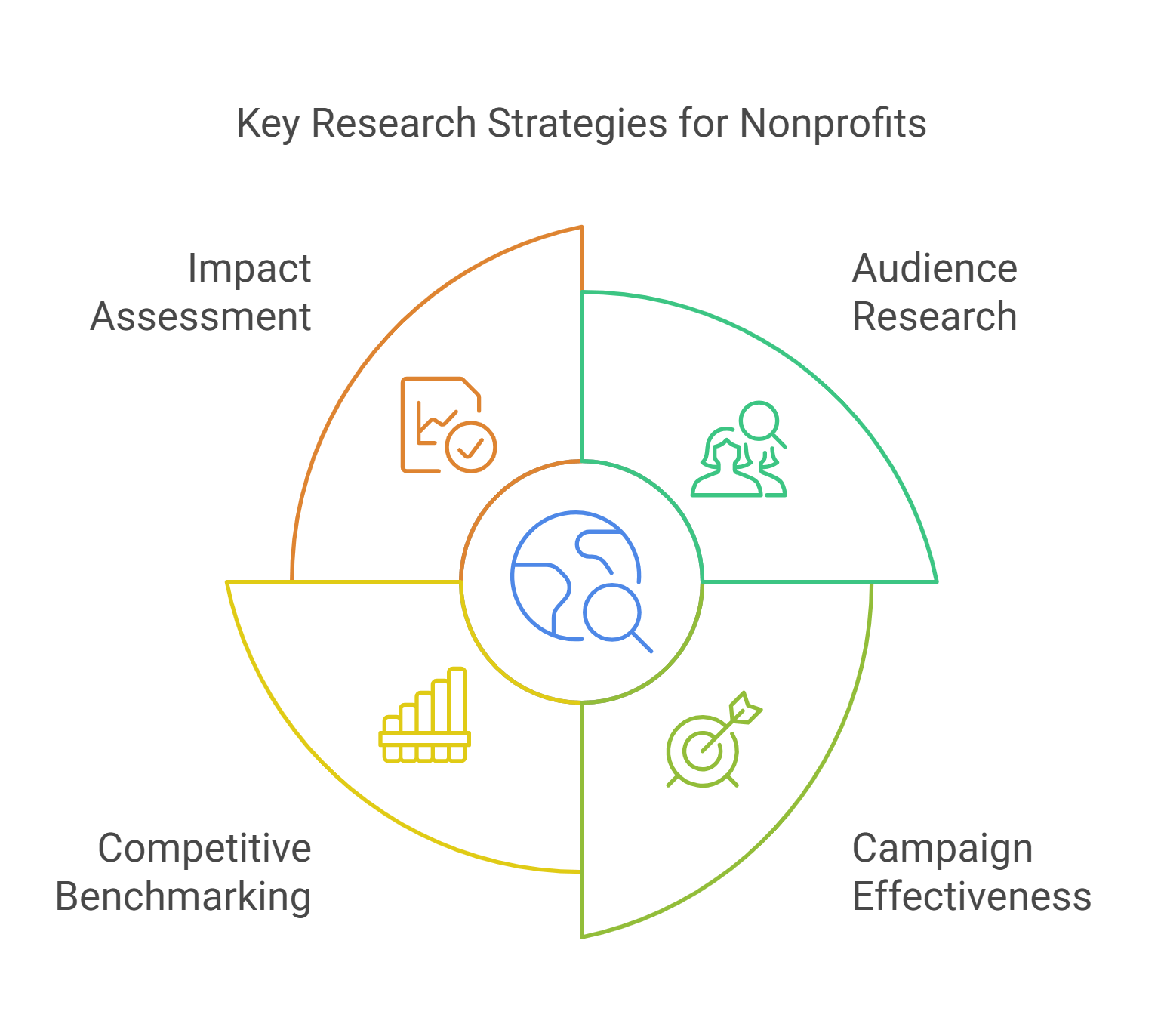非営利市場調査

As the CEO of SIS International Research, I’ve seen countless organizations striving to make the world a better place. Among them, nonprofits hold a special place. These organizations are driven by purpose rather than profit, but their challenges are no less complex. That’s where non profit market research becomes indispensable.
Why Non Profit Market Research is Crucial

Running a nonprofit is a delicate balancing act. You need to connect with donors, serve communities, and stay true to your mission—all while operating within tight budgets. Without non profit market research, it’s like sailing without a compass – and research provides the insights nonprofits need to:
- Identify and understand their target audiences.
- Optimize fundraising strategies.
- Measure the effectiveness of programs and campaigns.
- Communicate their impact with clarity and confidence.
Take, for instance, a nonprofit we partnered with last year. They were struggling to retain donors and couldn’t pinpoint why. Through in-depth donor surveys, we uncovered that 41% of their contributors wanted more transparency about how their funds were used. Implementing a detailed reporting system boosted donor retention by 34% in just five months.
Key Areas of Non Profit Market Research
Nonprofits operate in diverse sectors, from education and healthcare to environmental protection and social justice. Regardless of the cause, these are the key areas where non profit market research can make a difference:

1. Audience Research
Do you know who supports your cause? Audience research helps nonprofits understand the demographics, preferences, and motivations of their donors, volunteers, and beneficiaries.
2. Campaign Effectiveness
Every campaign needs measurable results. Research evaluates what works and what doesn’t, ensuring that resources are allocated effectively.
3. 競合ベンチマーク
Understanding what similar organizations are doing can provide valuable insights and identify gaps in your strategy. One environmental nonprofit we worked with used benchmarking to discover that their peer organizations were far ahead in digital outreach.
4. Impact Assessment
Nonprofits often struggle to quantify their impact. Research methods like surveys, interviews, and data analysis provide tangible evidence of success, which can be shared with stakeholders and donors.
The Role of Data in Non Profit Market Research

Data is at the heart of effective non profit market research... But it’s not just about numbers; it’s about interpreting them to tell a story. In the nonprofit sector, where resources are limited and accountability is critical, leveraging data effectively can mean the difference between thriving and merely surviving.
Here’s how data plays a transformative role in non profit market research:
1. Identifying Trends and Opportunities
Data helps nonprofits stay ahead of the curve by identifying emerging trends, donor preferences, and community needs. For example, analyzing donor behavior might reveal an increased interest in environmental causes, enabling a nonprofit to tailor its messaging and initiatives to align with this growing concern.
2. Measuring Impact and Accountability
Through surveys, case studies, and analytics, nonprofits can demonstrate how their programs are improving lives.
3. Improving Decision-Making
Nonprofits often operate with limited budgets and tight timelines. Data-driven insights enable smarter decisions, ensuring that every dollar and every effort is directed toward the most effective initiatives. For instance, tracking the performance of a fundraising campaign in real-time allows nonprofits to pivot strategies if engagement falls short.
4. Enhancing Donor Relationships
Data allows nonprofits to personalize their approach to donor engagement. It helps nonprofits to create targeted campaigns, send tailored thank-you messages, and recommend causes that align with each donor’s interests.
5. Enabling Transparent Communication
Data empowers organizations to share clear, honest reports with stakeholders, showcasing how funds are used and the outcomes they’ve achieved.
6. Optimizing Campaigns and Programs
Nonprofits can analyze which campaigns resonate most with their audiences, which social media posts drive engagement, and which programs deliver the highest return on investment.
7. Predicting Future Needs
Predictive analytics can guide nonprofits in anticipating challenges and opportunities, from planning for natural disasters to identifying shifts in donor behavior.
Strategies to Maximize the Value of Non Profit Market Research

Nonprofits often operate within tight budgets and limited resources, so it’s crucial to ensure that every research effort delivers maximum impact. – and these strategies will help you get the most out of your non profit market research:
1. Start with Clear Objectives
Define the specific questions you want answered. Are you trying to understand donor behavior, evaluate a program, or measure community needs? Clear goals will keep your research focused and prevent wasted time or resources.
2. Leverage Technology for Smarter Insights
Take advantage of modern tools to streamline data collection and analysis. For example:
-
- Use CRM systems to track donor engagement and fundraising patterns.
- Implement online surveys to quickly gather feedback from stakeholders.
- Analyze trends using social media analytics to understand how your audience interacts with your cause.
3. Collaborate with Experienced Experts
Research firms like SISインターナショナル bring specialized expertise to the table. Partnering with professionals ensures high-quality data collection, analysis, and actionable recommendations. Experts can help you uncover deeper insights and avoid common pitfalls, freeing up your team to focus on execution.
4. Engage Diverse Stakeholders
Include your entire community—donors, volunteers, staff, and beneficiaries—in the research process. This creates a 360-degree view of your organization’s impact and opportunities. For example, surveying volunteers might reveal gaps in training, while beneficiaries can provide valuable feedback on program effectiveness.
5. 実用的な洞察に焦点を当てる
Data alone isn’t enough. Prioritize research methods that lead to clear, practical outcomes. Instead of simply asking for general feedback, frame questions that point to solutions, such as, “How can we improve donor retention?” or “Which programs have the highest perceived value?”
6. Monitor Progress and Adjust Accordingly
Use insights as a foundation for continuous improvement. Track your performance over time, measure the impact of implemented changes, and refine your strategies as new data becomes available.
7. Prioritize Transparency in Findings
Once your research is complete, share the results with stakeholders. Transparency builds trust and fosters accountability.
8. Balance Qualitative and Quantitative Data
Don’t rely solely on numbers. Incorporate qualitative data, such as interviews and testimonials, to bring a human perspective to your research. Combining statistics with personal stories creates a compelling narrative that resonates with stakeholders.
9. Make Data Collection an Ongoing Process
Rather than treating research as a one-off project, make it an integral part of your operations. Regularly collect data to track trends and adapt to changing circumstances.
10. Embrace a Culture of Learning
Finally, foster an organizational mindset that values research and data-driven decision-making. Empower your team to use insights for strategic planning, and celebrate successes based on measurable outcomes. When everyone understands the importance of research, its value multiplies.
A Case Study in Non Profit Market Research Success

Let me share a story that highlights the power of research. A global nonprofit focused on disaster relief wanted to improve its emergency response efforts. Through comprehensive research, we identified two key issues:
- Inefficient communication between field teams and headquarters.
- A lack of real-time data on supply distribution.
Our team recommended implementing a mobile app for real-time tracking and communication. Within a year, the nonprofit saw:
- A 37% reduction in response time.
- Improved resource allocation, cutting costs by 25%.
- Higher donor confidence, leading to a 17% increase in funding.
This is what non profit market research can achieve when done right!
The Future of Non Profit Market Research
The nonprofit landscape is constantly evolving, with new challenges and opportunities emerging daily. Trends like digital transformation, increased focus on sustainability, and changing donor expectations will shape the future of the sector. So, nonprofits that embrace non profit market research will be better equipped to navigate these changes and amplify their impact.
よくある質問
What is non profit market research?
Non profit market research analyzes data to help nonprofits better understand their audiences, measure the impact of their programs, and optimize their strategies to achieve their missions.
Why is market research important for nonprofits?
Market research helps nonprofits connect with donors, engage their communities, and allocate resources effectively. It provides data-driven insights that guide decision-making and demonstrate transparency to stakeholders.
What methods are used in non profit market research?
Common methods include surveys, focus groups, in-depth interviews, data analysis, and social media analytics. Advanced techniques like impact assessments and donor behavior modeling are also used.
How does market research improve fundraising efforts?
Research identifies donor preferences, motivations, and behaviors, enabling nonprofits to create targeted campaigns that resonate with their supporters and improve fundraising outcomes.
Why choose SIS International Research for non profit market research?
SIS brings decades of expertise, a global perspective, and cutting-edge methodologies to deliver actionable insights. We partner with nonprofits to amplify their impact and achieve their goals.
ニューヨークの施設所在地
11 E 22nd Street、2階、ニューヨーク、NY 10010 電話: +1(212) 505-6805
SISインターナショナルについて
SISインターナショナル 定量的、定性的、戦略的な調査を提供します。意思決定のためのデータ、ツール、戦略、レポート、洞察を提供します。また、インタビュー、アンケート、フォーカス グループ、その他の市場調査方法やアプローチも実施します。 お問い合わせ 次の市場調査プロジェクトにご利用ください。


